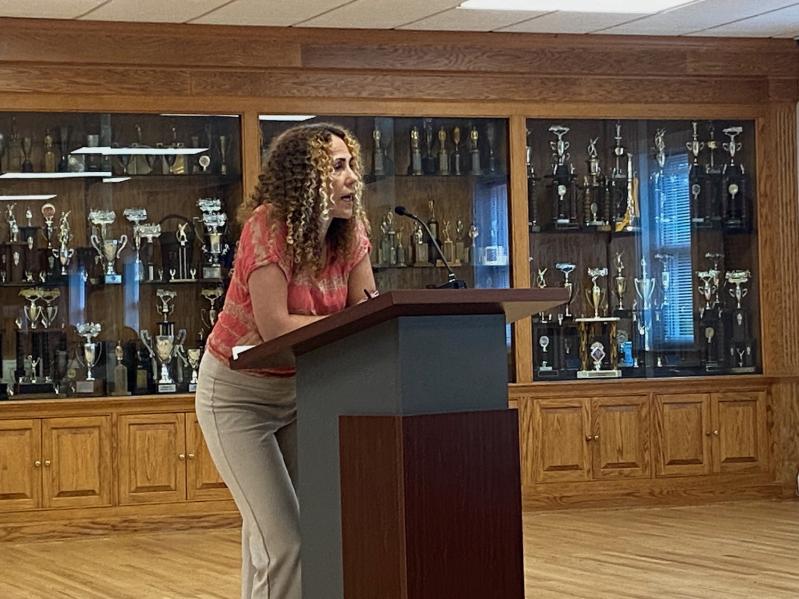A vehicle pulled over in Patchogue, its four occupants, on their way to work, taken from it and put into another vehicle, which drives away. Immigration and Customs Enforcement, or ICE, officials emerging from unmarked vehicles and detaining a man in Riverhead on Monday. Unidentified men descending on a North Fork laundromat on a Sunday morning, purportedly searching for an individual but instead questioning random patrons.
These were just a few of the accounts shared, via video or verbal testimony, during a virtual meeting this week of Progressive East End Reformers, or PEER, a chapter of the New York Progressive Action Network, as it hosted representatives from Organizacion Latino Americana of Eastern Long Island, or OLA, and Long Island Immigrant Student Advocates.
As early as 5:30 a.m., said Osman Canales of Long Island Immigrant Student Advocates, messages from across Long Island appear on his mobile phone: ICE is in the community. “They have seen cars outside parked, waiting for workers to leave their homes,” he said. “That’s how they get them now. We used to see them coming to the house, knocking on the door, they open the door, and they arrest whoever they find in the house,” regardless of any criminal history. “They were in the process of getting their green cards and they were taken,” he said of a mother and daughter in Mastic. “And now they’re back in Colombia.”
ICE, he said, is “targeting individuals, but they also are detaining individuals that are standing at Home Depot looking for a job. They have done that at multiple locations in Huntington, in Copiague, in Freeport, in Westbury.”
The discussion laid bare the impacts of ICE agents searching for undocumented immigrants, a dragnet that across the country has snared multiple United States citizens and immigrants in the process of attaining legal status. In addition to the myriad economic, social, and psychological impacts on immigrants, the Trump administration’s 2024 campaign promise of “mass deportation now” is impacting local businesses as well, the speakers said.
“Parents are not sending their kids to school when they are alerted that ICE is in the community” Mr. Canales said. “So we have teachers with empty classrooms, or half-empty classrooms, howing up for work because they’re afraid to leave their homes. This not just impacts our immigrant community, but it also impacts our entire community because now there are businesses not able to function because their workers are not coming into work, or their workers are being detained.”
The reality, said Minerva Perez of OLA, is that “we are so much less safe than we have ever been.” Children are staying away from school, people are not going to doctors’ offices or reporting crimes, be they victims or witnesses, she said. “They don’t want to have their name out there. They just don’t want to be on any kind of record.”
In such an environment, the vulnerable are especially ripe for exploitation. Calls to OLA’s advocacy team have quadrupled since January, Ms. Perez said. Wage theft is at the highest level she has ever seen. Violence against women and illegal evictions are going unaddressed, she said. “They’re all interconnected. All of these things related to these raids and these actions, and where our institutions are falling down over and over again, is creating the most unsafe environment that we’ve ever seen.”
And, Mr. Canales said, this is not about illegal immigration. Many of those being detained and deported have been granted Temporary Protected Status or a temporary work permit and protection from deportation through the Deferred Action for Childhood Arrivals program, “like a student, a young man from Riverhead” who was detained a few months ago, he said. “They’re not, like we hear them say, going after criminals. That is just a big lie.”
As The Star reported in June, OLA has launched a rapid response action plan in response to ICE arrests happening on Long Island. Operation Stand and Protect was established to provide access to “an active cohort of local volunteers who are ready to witness, engage, and act swiftly and peacefully to document ICE activities,” according to the organization. The group offers training to prepare volunteers to witness and document ICE activity in a peaceful and legal way.
Under the program, alerts are sent to volunteers notifying them of “locations where their presence could make a meaningful impact,” according to the group’s materials. Upon receiving an alert, they are to contact a 24-hour hotline to confirm their availability and provide an estimated arrival time. They are asked to submit videos, photos, voice notes, or detailed text descriptions through the hotline.
“What we’re seeing on the East End of Long Island is a lot of actions that are quicker, they’re in and they’re out,” Ms. Perez said. “By the time we get there, they’re gone.” Hence the rapid response plan. “A lot of what we do with rapid response is not just documenting, witnessing, hoping to deter,” she said. “A lot of what we’re also focusing on is being able to know who was affected, who was left behind. So when we’re able to, we’re working immediately with the wife, we’re already trying to connect a lawyer to that person who’s been detained, because they work so quickly. You can be detained in Yaphank, end up in New Orleans a matter of hours after that, and God knows where they’re going to send you. So it’s being able to be in that moment.” Similar efforts are in place elsewhere on the east end of Long Island, she said.
“There’s a lot of us, and our neighbors and friends, who are living now in fear and anxiety,” said Kathryn Szoka of PEER. “I want to just pause and say, let’s remember we’re not alone, we’re in this together. We’re part of a robust network of democracy defenders, and all of those defenders are working hard to help others and to save our democracy.”




